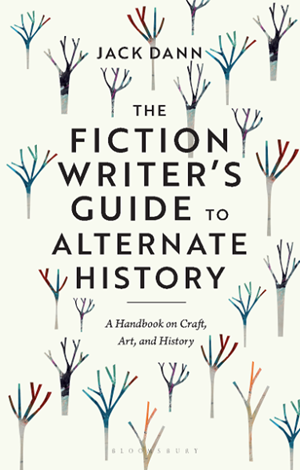The Fiction Writer’s Guide to Alternate History
 I discovered The Fiction Writer’s Guide to Alternate History thanks to an interview with Jack Dann on The Coode Street Podcast. If you want hear Dann discussing the book and its origins with Gary Wolfe and Jonathan Strahan, you can do so here.
I discovered The Fiction Writer’s Guide to Alternate History thanks to an interview with Jack Dann on The Coode Street Podcast. If you want hear Dann discussing the book and its origins with Gary Wolfe and Jonathan Strahan, you can do so here.
In terms of writing manuals, this one is very specific, unlike the far more general work by Angus and Nolan reviewed elsewhere in this issue. This allows Dann to go into a lot more depth. He starts off by defining what (he thinks) Alternate History is. He then talks more generally about history as a practice. He gives an example of an Alternate History short story. He talks about the problems that writers will face writing this sort of work and how they should be tackled. He then has a round-table discussion with a bunch of authors, in which several of them profoundly disagree with him. Finally he talks about his own journey writing an Alternate History novel, and shares some thoughts about how you, the reader, might go forward from there.
Dann’s definition of Alternate History is quite narrow. In particular he references Tom Shippey, in whose opinion a true Alternate History (or Counterfactual Fiction) should be based on a single divergence point from actual history (sometimes known as a “Jonbar Point”) which should be 1) plausible; 2) definite; 3) small in itself; and 4) massive in consequence. This is history viewed through the lens of the nursery rhyme, “For the Want of a Nail”.
I have some fairly strong disagreements with that, as did many of the authors who participated in the round table. However, I’m going to leave most matters of definition for the talk I’m giving at Bristol Central Library next month as part of their support of the British Library’s Fantasy exhibition. That talk will become an essay that you can all read sometime next year.
For this review I want to focus on the usefulness of Dann’s book as what it purports to be: not an academic examination of what Alternate History is, but a guide for practitioners. The definitional material is useful as a launch pad for discussion, but in my view the real value of the book is in the advice Dann gives, and the round table.
Two key bits of advice that Dann gives are concerned with worldbuilding, and with how to stop it taking over your book. He discusses the Dos Passos technique of inserting quote from invented media material (newspaper clippings, quotations from politicians, long lyrics and so on) which has been used to great effect by the likes of John Brunner and Lyda Morehouse. But he also cautions against getting lost in the rabbit hole of your research and allowing that to gush out onto the page.
In the round table, Dann starts off by citing Shippey’s definition, and some ideas of his own, and asks the various writers whether they think those concepts are central to creating Alternate History. Some authors enthusiastically agree, but others are much less convinced. Harry Turtledove, whom you might think knows what he’s talking about on this topic, says:
“Central? I don’t think in such terms. Nothing is central to a story except plot, characters, and style, not necessarily in that order at all.”
Janeen Webb is more specific in her criticism. She says:
“I agree that counterfactual fiction is defined by its relationship with known historical events. But I disagree about the necessity for a single divergence point.”
It isn’t mentioned in this book, but Webb is Jack Dann’s wife. They’ve been together for almost 30 years, so definitions of Alternate History are clearly not important to their relationship.
Some writers are very keen to stress the need for believability. There is massive disagreement over Howard Waldrop’s story, “Ike at the Mic”, in which Dwight D Eisenhower becomes a jazz musician and Elvis Presley becomes a politician. Some writers celebrate this as groundbreaking, while others dismiss it as wanton breaking of the sacred rules of the genre. John Kessel describes it as “completely bogus”.
Some writers think that to great a deviation from actual history will make a book mere fantasy. Charlaine Harris, on the other hand, states:
“It was relatively easy to pick the divergence point for the Sookie Stackhouse novels: vampires have decided to make their existence public.”
My favourite contributions come, rather surprisingly, from Chris Priest. His responses tend to be of the forms, “No”; “-a longer phrase meaning ‘No’-”; and “No -followed by a justification of his rejection-”. At one point he comments:
“I didn’t become a writer so that I could follow the rules of others. The moment I hear about a rule I either ignore it or look for a way to subvert it.”
And he’s right. Perhaps not in the way he wants to be, in that he might see himself as special and different, but because every writer is different. What I love about this book is that it takes a fairly small part of the speculative fiction field and demonstrates that there is massive disagreement amongst respected and successful writers as to how such works should be crafted, and even about why one should attempt them in the first place. That’s a valuable lesson for any wannabe writer.

Title: The Fiction Writer’s Guide to Alternate History
By: Jack Dann
Publisher: Bloomsbury
Purchase links:
Amazon UK
Amazon US
Bookshop.org UK
See here for information about buying books though Salon Futura